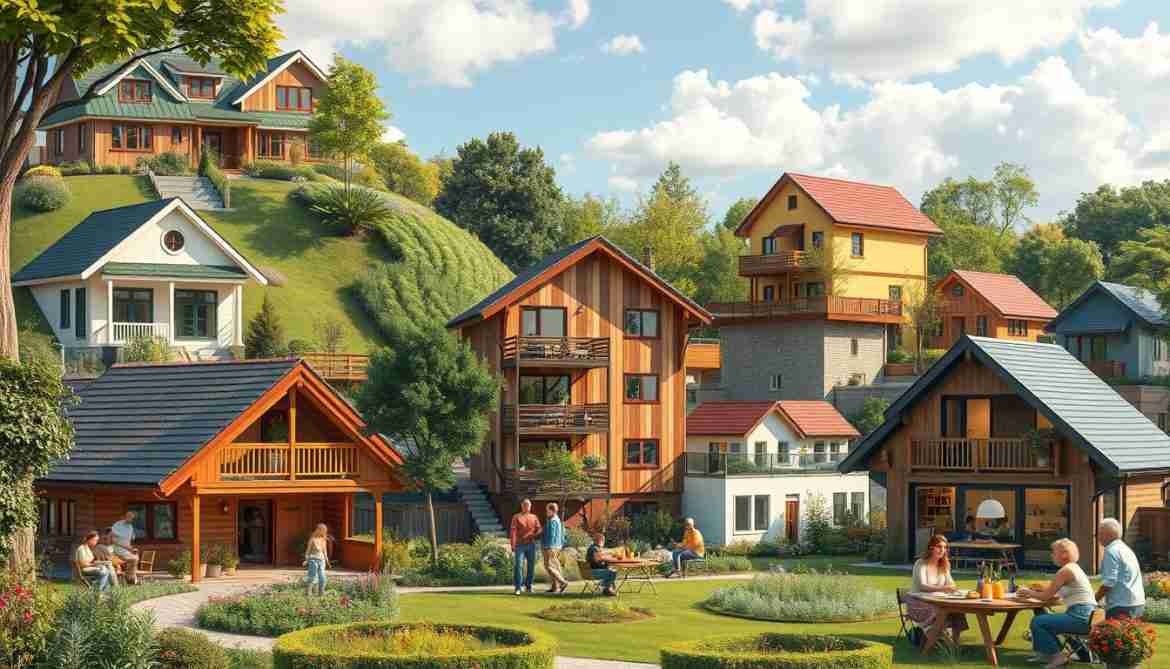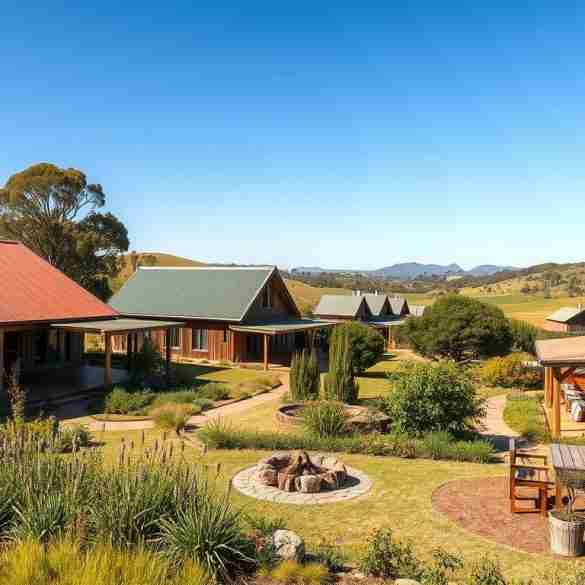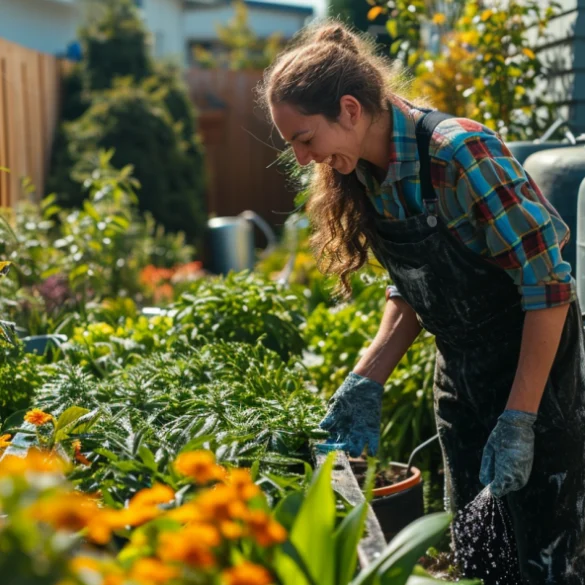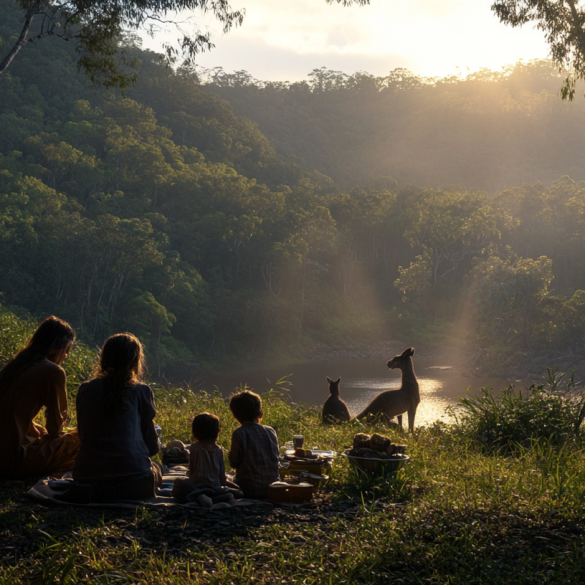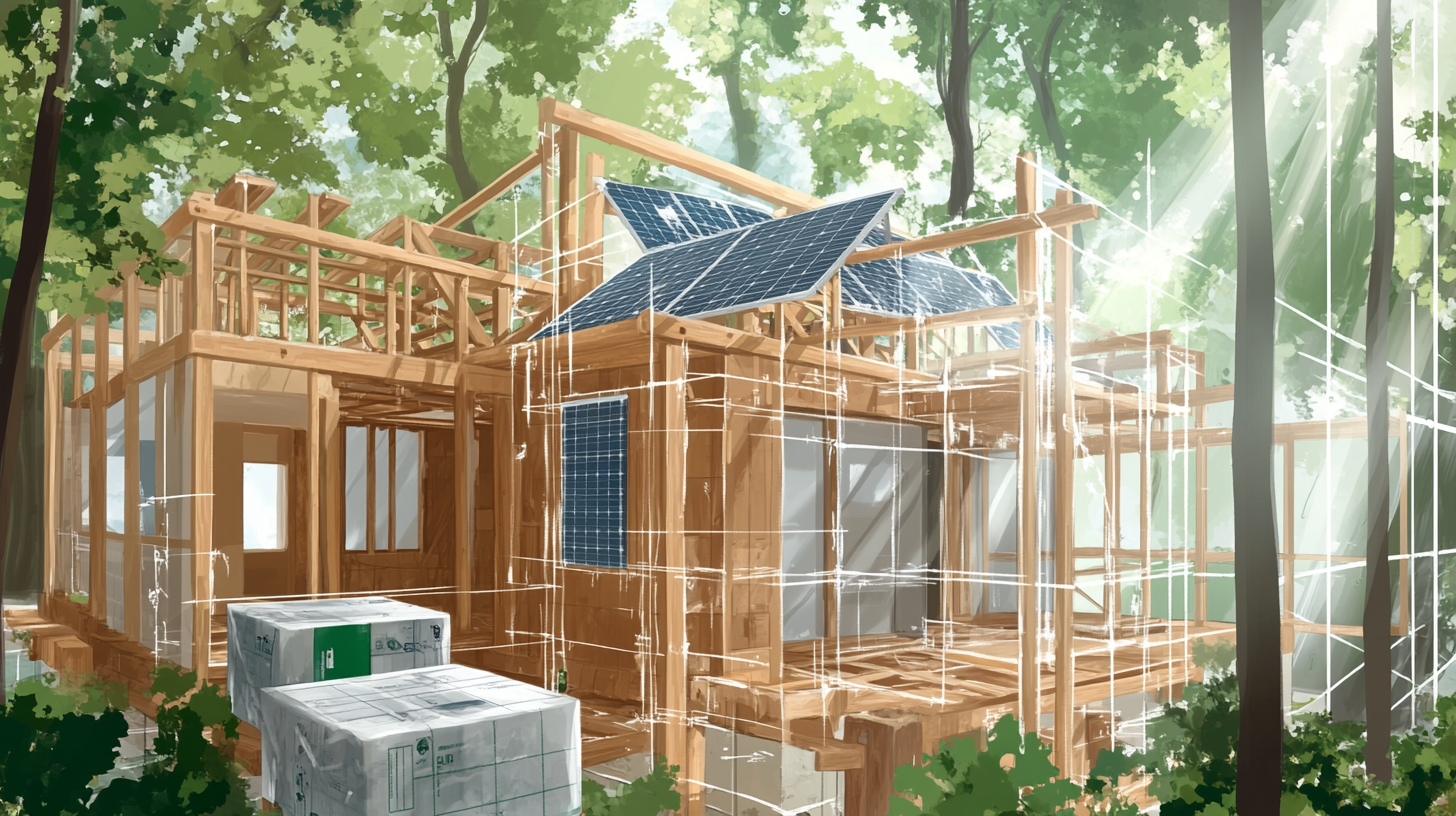Ever dreamed of living in a community where you know your neighbors? Where you share common spaces and work together for a better life? If yes, you might like co-housing communities. They’re becoming more popular in the United States.
There are over 170 cohousing communities in 36 states, says the Cohousing Association of the United States (Coho/US). Most have 20 to 40 households. This setup lets people enjoy shared spaces but keep their privacy.
Co-housing started in Denmark and came to the United States in the late 1980s. Since then, it has grown into many community living options. Each has its own special features and benefits, from urban projects to rural ecovillages.
Exploring co-housing communities shows how they can be more affordable and sustainable. A survey found that cohousing residents save at least $200 a month. Some save over $2,000 a month.
Key Takeaways
- Co-housing communities offer a more affordable, sustainable, and socially connected way of life.
- There are over 170 cohousing communities in 36 states across the United States.
- Co-housing communities typically consist of 7 to 67 individual units, with most hosting between 20 and 40 households.
- Residents of co-housing communities can enjoy significant financial savings on their monthly budgets.
- Different types of co-housing cater to various lifestyles and preferences, from urban projects to rural ecovillages.
Urban Co-Housing
In the heart of cities, a new way of living is growing: urban co-housing. It mixes private homes with shared spaces. This way of living brings people together, supports the environment, and creates a sense of belonging.
Characteristics of Urban Co-Housing Communities
Urban co-housing combines private and shared spaces. In cities, it often looks like condos or townhouses. Residents have their own homes but also share common areas.
- Community houses for gatherings and events
- Shared kitchens and dining areas
- Playgrounds and green spaces
- Rooftop gardens and farms
- Workshops and creative spaces
Parking is often underground to save space. These communities are also close to public transit. This helps reduce car use and supports green travel.
Examples of Urban Co-Housing Projects
In the U.S., many urban co-housing projects are starting. Doyle Street Cohousing in Emeryville, California, is one example. It turned a cement factory into a community with 12 condos and a common house.
Capitol Hill Urban Cohousing in Seattle, Washington, is another great example. It has 28 residents, including 11 kids. The building has nine homes, from 810 to 1,300 square feet.
| Urban Co-Housing Project | Location | Number of Units |
|---|---|---|
| Doyle Street Cohousing | Emeryville, CA | 15 (12 condos, 3 townhouses) |
| Capitol Hill Urban Cohousing | Seattle, WA | 9 homes |
| Aria Cohousing | Denver, CO | 28 units |
| Takoma Village Cohousing | Washington, D.C. | 43 units |
Advantages and Challenges of Living in Urban Co-Housing
Urban co-housing has many benefits. It fosters a strong community and promotes green living. Residents enjoy shared activities and sustainable practices.
“Urban co-housing has given me a true sense of belonging in the city. I love having my own space while also being part of a vibrant, supportive community.”
But, it also has challenges. Finding land in cities is hard and expensive. Navigating zoning rules can be tough too.
Despite these hurdles, the benefits of urban co-housing are clear. As more seek community and sustainability in cities, it will shape urban living’s future.
Rural Co-Housing
Rural co-housing offers a unique chance to live in nature and build a community. It’s different from city co-housing, which has less space. Rural homes are spread out on big plots of land.

Features of Rural Co-Housing Communities
Rural co-housing has single-family homes or duplexes on big land. This mix of personal and shared space is special. For example, the Winslow Cohousing Group in Washington has 30 homes on almost 6 acres.
These communities save land for farming, fun, and animals. Homes are close together, so lots of land is for green spaces and shared areas.
Community and Sustainability Focus in Rural Settings
Rural co-housing focuses on being green and caring for nature. The Ecovillage in New York is a great example. It’s on 175 acres, with 90% for farming and animals.
These communities also build strong bonds. People share in gardening, farming, and outdoor fun. This creates a sense of belonging.
Challenges Unique to Rural Co-Housing Projects
Rural co-housing has its own challenges. It’s far from city services like healthcare and schools. This makes daily life harder.
Managing big land is another big job. Communities spend a lot of time and effort on upkeep. This is crucial for their shared property.
| Community | Location | Number of Homes | Land Area |
|---|---|---|---|
| Winslow Cohousing Group | Bainbridge Island, WA | 30 | 6 acres |
| Ecovillage | Ithaca, NY | – | 175 acres (90% green space) |
| Heartwood Cohousing | Southwest Colorado | 24 single-family homes | 361 acres |
| Frog Song | Cotati, CA | 30 families | 2.3 acres |
Despite challenges, rural co-housing is appealing. It offers a sustainable, community-focused lifestyle. As more seek alternative living, rural co-housing will likely grow in popularity.
Eco-Village Co-Housing
Eco-village co-housing is a special way to live that cares for the earth and builds community. These places aim to use less resources and bring people together. They are designed to be good for the planet and for each other.
Definition and Principles of Eco-Villages
Eco-villages are special communities that focus on being green and connected. They have 50 to 500 members. The Global Ecovillage Network helps them share ideas and resources.
How Sustainability Is Integrated into Daily Living
In eco-villages, living green is part of everyday life. People work together on many projects. For example:
- They grow food organically and use permaculture.
- They use solar panels and wind turbines for energy.
- They share tools, cars, and spaces.
- They design homes to be energy-efficient and use natural materials.
- They reduce waste by recycling and composting.
By doing these things together, eco-villages show it’s possible to live well and green.
Examples of Successful Eco-Village Co-Housing Projects
Nevada City Cohousing in California is a great example. It has 36 homes that work together to make more energy than they use. This makes it a leader in green living.
| Eco-Village Co-Housing Project | Location | Number of Units | Sustainability Features |
|---|---|---|---|
| Nevada City Cohousing | California, USA | 36 | Net-positive solar energy, passive solar design, natural building materials |
| Findhorn Ecovillage | Scotland, UK | 100+ | Renewable energy, ecological wastewater treatment, organic farming |
| Ecovillage at Ithaca | New York, USA | 175 | LEED Platinum certified homes, car-sharing program, organic CSA farm |
Findhorn Ecovillage in Scotland and Ecovillage at Ithaca in New York are also successes. They show eco-villages can create strong, green communities for everyone.
Senior Co-Housing
Senior co-housing is a special living setup for older adults. It helps them live independently but with community support. As more people age, the need for these homes has grown a lot.
In the U.S., over 295 cohousing communities exist. About 45 of these are for seniors, either built or in development.
Co-Housing Designed for Aging Populations
Senior co-housing is for people 55 and older. These homes are built to help older adults live together and share resources. This idea started in Denmark in the 1960s and now exists worldwide.
The first U.S. senior cohousing is Silver Sage Village in Boulder, Colorado. It’s part of the Permanently Affordable Housing Program. Some places, like Village Hearth Cohousing in Durham, North Carolina, welcome LGBTQ older adults.
How Senior Co-Housing Promotes Active Aging
Senior co-housing encourages older adults to stay active and engaged. It focuses on social connections, physical activity, and learning. Residents enjoy privacy but also participate in community activities.
These communities have common spaces for socializing and sharing. They aim to build a strong sense of community. Decision-making is done through regular meetings and consensus.
Benefits of Co-Housing for Seniors (Social Interaction, Care)
Senior co-housing has many benefits. It helps older adults feel connected and emotionally well. It also offers access to shared resources.
Living in a supportive community helps fight loneliness. Residents can learn new skills, help out in the community, and join classes. This keeps them active and engaged.
| Benefit | Description |
|---|---|
| Social Interaction | Senior co-housing fosters social connections and a strong sense of community, reducing isolation and loneliness. |
| Cost Savings | Sharing resources and self-management of the community can lead to significant cost savings for residents. |
| Emotional Well-being | Living in a supportive community contributes to improved emotional well-being and overall quality of life. |
| Lifelong Learning | Senior co-housing provides opportunities for residents to develop new skills, participate in activities, and engage in community service. |
Senior co-housing also offers practical benefits. It allows older adults to share costs for care services. This is a better option than assisted living, letting them stay in their homes.
Multi-Generational Co-Housing
In today’s world, families are often far apart. Multi-generational co-housing brings people together. It’s a place where families of all ages live together, creating a supportive community. Intergenerational living in co-housing brings joy and benefits to all.
Fostering Intergenerational Connections
Co-housing lets people of all ages connect deeply. Young families get wisdom from elders. Elders find joy in helping the young. They share activities and spaces, feeling like they belong.
Benefits for Families and Older Adults
Co-housing helps families and seniors a lot. Young families get help from elders. This helps with childcare and eases stress.
Seniors get companionship and a sense of purpose. They feel connected and valued.
“Living in a multi-generational co-housing community has been a life-changing experience for our family. Our children have formed incredible bonds with their elder neighbors, and we’ve found a level of support and connection that we never knew was possible.” – Sarah, co-housing resident
Examples of Successful Multi-Generational Co-Housing
The SällBo project in Sweden is a great example. It has 51 apartments, with 60% for seniors. The rest is for young refugees and those under 25.
Everyone must join in communal activities for two hours a week. This builds a strong sense of community.
| Age Group | Percentage of Apartments |
|---|---|
| Elderly (70+) | 60% |
| Young Refugees (18-25) | 20% |
| Individuals Under 25 | 20% |
The SällBo project shows the strength of diversity in co-housing. It brings together people from different backgrounds. They form strong bonds through activities like cooking and gardening.
As more people join multi-generational co-housing, SällBo inspires us. It shows the power of connection and intergenerational living.
Intentional Communities
Intentional communities are special places where people live together based on shared values. They attract those who want to connect with others who share their beliefs. You can find these communities all over the world, including in the United States, Europe, Australia, and more.
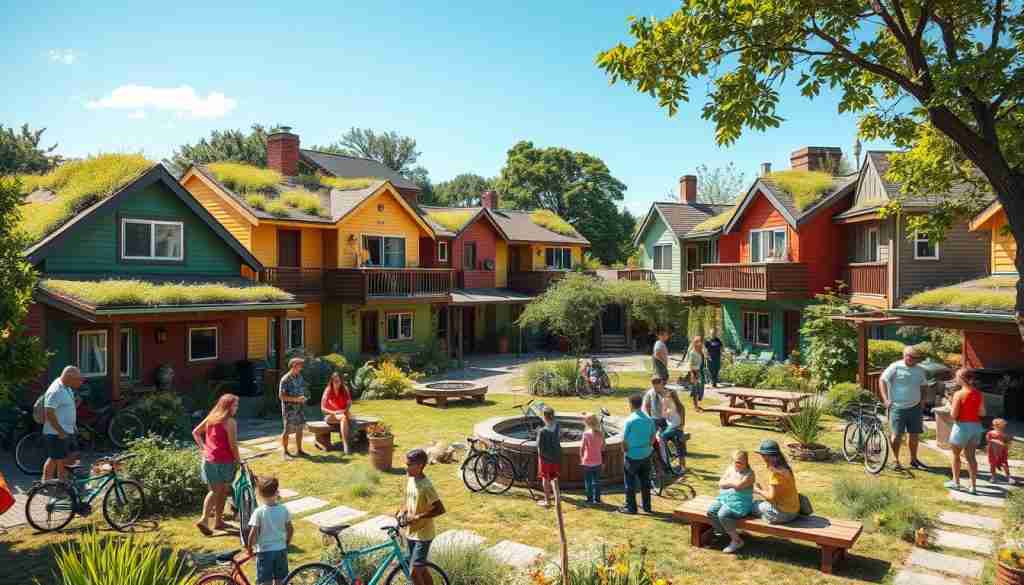
Philosophy and Values in Intentional Communities
Intentional communities focus on a shared philosophy or values. These values can be about spirituality, caring for the earth, fighting for justice, or certain lifestyles. People in these communities choose to live together, supporting each other in their values.
For example, the Bruderhof Communities are found in several countries and follow Christian principles. They live together and help others. Eco-focused communities like Dancing Rabbit Ecovillage in Missouri aim to live sustainably and reduce their environmental impact.
Key Differences Between Intentional Communities and Traditional Co-Housing
Intentional communities and traditional co-housing both value community and shared spaces. Yet, there are key differences:
- Intentional communities ask for a deeper commitment to their values and way of life.
- They often make decisions by consensus, focusing on shared principles.
- Intentional communities have more structured activities and expect members to participate.
- Traditional co-housing focuses on practical benefits like sharing costs and amenities. Intentional communities focus more on living out a shared worldview.
Types of Intentional Co-Housing (Spiritual, Political, etc.)
Intentional communities vary, each with its own focus and values. Some common types include:
- Spiritual communities: These focus on shared religious or spiritual practices, like Taizé Community in France or Findhorn Foundation in Scotland.
- Eco-villages: They focus on sustainable living and reducing environmental impact, such as Auroville in India or Avalon Organic Gardens & EcoVillage in Arizona.
- Political or social justice communities: These are organized around shared political beliefs or a commitment to social equity, like the Life and Labor Commune in Russia (1921-1939) or the Twin Oaks Community in Virginia.
- Lifestyle-focused communities: They are built around a shared way of life, such as the Whole Village community in Ontario, which emphasizes holistic health and personal growth.
| Region | Notable Intentional Communities |
|---|---|
| United States | Dancing Rabbit Ecovillage (MO), Twin Oaks Community (VA), Acorn Community (VA), Koinonia Farm (GA) |
| Europe | Taizé Community (France), Findhorn Foundation (Scotland), Damanhur (Italy) |
| Australia | Gondwana Sanctuary (Byron Bay), Crystal Waters (Queensland) |
| Asia | Auroville (India), Jinwar (Syria) |
| South America | Gaviotas (Colombia), Mazunte (Mexico) |
Exploring intentional communities reveals a rich variety of shared principles and lifestyles. Whether you seek a community that aligns with your values or are simply curious, intentional communities offer a unique perspective on living together.
“Intentional communities are a reminder that we have the power to create the kind of world we want to live in, one choice at a time.” – Ma’ikwe Ludwig, author and intentional community advocate
Cohousing for Digital Nomads
Co-living communities are becoming popular for digital nomads and remote workers. They offer flexibility and community. These workers need reliable internet, dedicated workspaces, and chances to network.
Flexible Living Arrangements for Remote Workers
Digital nomad co-housing offers short-term rentals. This is great for those who travel a lot or need to move often. You can find private rooms or apartments that fit your budget and style.
Co-Living Spaces Tailored for Digital Nomads
Co-living spaces for digital nomads have everything needed for work and comfort. They have coworking areas, private offices, and fast internet. Common areas let you meet and work with others.
| Accommodation Type | Pros | Cons |
|---|---|---|
| Hotels | Convenient, short-term stays | Expensive for extended periods, lack of community |
| Vacation Rentals | More space and amenities than hotels | Costly for longer stays, limited networking opportunities |
| Traditional Rentals | Long-term stability, privacy | Inflexible contracts, lack of community |
| Digital Nomad Co-Housing | Flexible contracts, tailored amenities, community living | Shared spaces may not suit all preferences |
Technological Infrastructure in Nomad Co-Housing
Good internet is key for remote workers. Digital nomad co-housing has strong tech to keep everyone connected. They have fast Wi-Fi, backup power, and tech support.
More people want flexible, community-focused homes. Digital nomad co-housing meets this need. It’s a new way to live and work, different from traditional rentals.
Luxury Co-Housing
Luxury co-housing is the top choice for shared living. It offers high-end amenities and stylish spaces. Sustainable Home Magazine talks about this trend and why it’s popular.

High-End Amenities in Co-Housing Communities
Luxury co-housing has many premium amenities. These include:
- State-of-the-art fitness centers and yoga studios
- Rooftop terraces with stunning views
- Infinity pools and spa facilities
- Gourmet kitchens and dining areas
- Cinema rooms and entertainment lounges
- Concierge services and housekeeping
These amenities make living like a five-star hotel. They let residents enjoy luxury while building community.
Design and Architecture of Luxury Co-Housing Spaces
Luxury co-housing has amazing designs. For example, Calq and Bond Society turned a 1970s office in Paris into Pong. It shows how old buildings can become luxury homes.
Other projects like Common Melrose in Los Angeles and Domūs Houthaven in Amsterdam focus on looks, function, and green living. They make spaces that are inspiring and beautiful.
| Project | Location | Key Features |
|---|---|---|
| Pong Co-Working & Co-Living Space | Paris, France | Converted 1970s office building, blended co-working and co-living spaces |
| Common Melrose | Los Angeles, USA | Communal living complex with high-end amenities and stunning design |
| Domūs Houthaven | Amsterdam, Netherlands | Residential complex prioritizing aesthetics, functionality, and sustainability |
Balancing Community and Exclusivity in Luxury Settings
Luxury co-housing aims to balance community and privacy. Residents enjoy shared activities and keep their personal space.
“Luxury co-housing offers the best of both worlds – the opportunity to be part of a vibrant community while enjoying the privacy and comforts of a beautifully designed personal space.” – John Smith, Co-Housing Expert
By choosing the right amenities and events, these communities help residents meet others. This mix is key to a happy and connected life for the wealthy.
Cooperative Housing (Co-ops)
Cooperative housing, or co-ops, is a special way to live together and own property. It started in London in 1859. In the US, it came in the late 1800s and grew during the Great Depression for affordable homes.
Co-ops used to help low-income families. But now, they also attract middle- and upper-income people in expensive cities. This is a new way to live compared to usual homes.
The Structure of Cooperative Housing
Co-op living means you buy shares, not a house. These shares let you live in a unit and help decide for the community. It’s a way for everyone to own and manage the place together.
| Ownership Model | Description |
|---|---|
| Market-rate cooperatives | Shares are bought and sold at market value, allowing for individual profit |
| Limited equity cooperatives | Share prices are restricted to maintain long-term affordability |
| Group equity co-ops | Members collectively own the property, with equity divided among all residents |
Decision-Making Processes in Co-ops
Co-ops are known for their democratic way of making decisions. Every member gets a say in big choices like who leads and what rules to follow. This makes everyone feel like they’re part of something important.
“Living in a co-op has taught me the value of collective decision-making and the power of community. It’s not just about having an affordable place to live; it’s about being part of something bigger than yourself.” – Sarah, a co-op resident in New York City
Differences Between Co-Housing and Co-Ops
Co-housing and co-ops both focus on community and shared spaces. But they differ in key ways:
- Co-housing has homes owned by individuals with shared areas. Co-ops have everyone owning the whole property together
- Co-housing is about building a community and doing things together. Co-ops focus on affordable housing and making decisions together
- Co-housing tries to agree on decisions. Co-ops make decisions by voting
Co-ops offer a unique chance to live affordably and be part of a community. They combine owning together and voting on decisions. This creates lively, involved communities where everyone has a say.
Student Co-Housing
Student co-housing is a new way for college students to live. It offers privacy and community. Students have their own bedroom and bathroom but share kitchens, living rooms, and study areas.
This model helps students grow and do well in school. It builds a sense of community and shared responsibility.
How Student Co-Housing Differs from Dormitories
Student co-housing is different from dorms. It has more space and privacy. Students have their own bedroom and bathroom.
Co-housing also has bigger common areas. These include kitchens, living rooms, and study spaces. This encourages students to work together and socialize.
Co-housing focuses more on community. It has events, meals, and group decisions. This helps students feel supported and connected.
Community Building and Shared Resources for Students
Co-housing helps students build a community. They work together on meals and chores. This builds teamwork and reduces costs.
Students also have fun together. They have movie nights and outings. This helps them make friends and find common interests.
Cost-Effectiveness and Accessibility of Student Co-Housing
Co-housing is cheaper than dorms or apartments. It splits costs among residents. This is good for students who want to save money.
| Type of Housing | Average Monthly Cost (USD) |
|---|---|
| Traditional University Dormitory | $800 – $1,500 |
| Off-Campus Apartment (Single Occupancy) | $1,000 – $2,000 |
| Student Co-Housing (Shared Occupancy) | $500 – $1,000 |
Co-housing is also close to campuses. This saves on travel costs. It lets students enjoy campus life more.
Living in a student co-housing community has been a game-changer for me. Not only have I saved money on housing expenses, but I’ve also gained a supportive network of friends who have become like family. It’s an experience that has enriched my college years in ways I never could have imagined.
In conclusion, student co-housing is a great choice for college students. It offers privacy, community, and is affordable. As more students look for new ways to live, co-living will likely grow.
Final Thoughts
Choosing co-housing means looking at many options. You can find places in cities or the countryside. There are communities for all ages and needs.
Co-housing is great because it offers both alone time and community. It helps you save money and feel supported. With over 160 communities in the US, there’s a lot to choose from.
If you want to find a co-housing community, start by looking online. (https://sustainablehomemag.com) is a good place to start. Go to meetings and talk to people living there. This way, you can find the right place for you.

